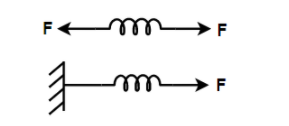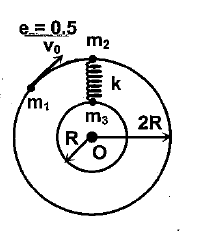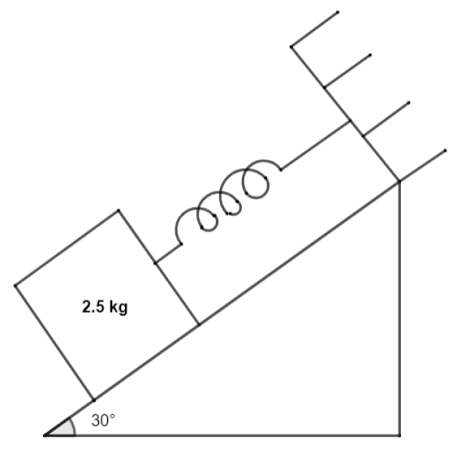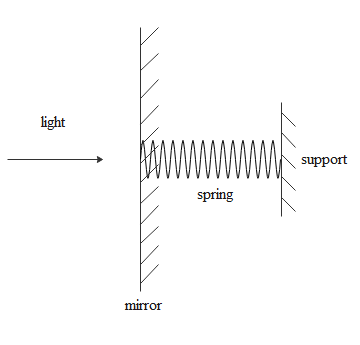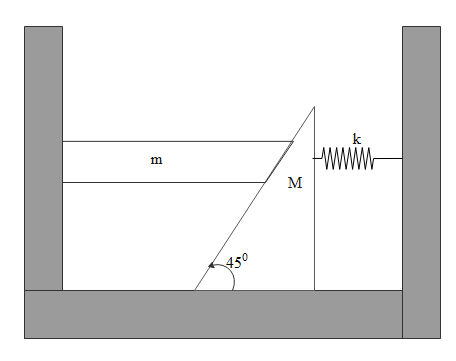Answer
52.5k+ views
Hint: - Here, write the value of restoring force in terms of spring constant and extension in each case from the given figure using Hooke’s law.
Formula Used: Here we will be using the formula for spring force given by Hooke’s law is ${F_{{\text{spring}}}} = - Kx$, where $K$ is the spring constant, $x$ is the extension in the string and ${F_{{\text{spring}}}}$ will be the spring force.
Complete step by step solution: -
The expression given by Hooke’s law for spring force is,
$ \Rightarrow {F_{{\text{spring}}}} = - Kx$
Here, negative sign indicates that the force exerted in an opposite direction by the spring to the spring displacement.
Consider the given two figures.
In the first figure, spring is pulled from both ends on either side by a force $F$.

The two forces exerted on the spring are in the opposite direction to each other. So the net force will be equal to the sum of both the forces acting on the spring. Thus, the net forces stretched force applied on the spring is,
$ \Rightarrow F = {F_{{\text{spring}}}} + {F_{{\text{spring}}}}$
And on adding it
$ \Rightarrow 2{F_{{\text{spring}}}}$
Here, the stretched force of spring from either end is $F$.
Now, substitute $Kx$ for spring force.
$ \Rightarrow F = 2Kx$
Rearrange the equation for extension of spring.
$ \Rightarrow x = \dfrac{{2F}}{K}$
But in this case, the displacement or extension produced from each end is reduced to half as both applied equal force to stretch the spring. So, displacement produced in this case is,
$ \Rightarrow x = \dfrac{x}{2}$
Now, the extension of spring is,
$ \Rightarrow \dfrac{x}{2} = \dfrac{{2F}}{K}$
And on solving for the value of $x$ , we get
$ \Rightarrow x = \dfrac{F}{K}$
In the second figure, a spring is tied to a wall and a force $F$is exerted to pull the spring.

Calculate the stretched distance of spring from the above figure.
$ \Rightarrow F = {F_{{\text{spring}}}}$
Here, the stretched force applied opposite to the wall is $F$ .
Now, substitute $Kx$ for spring force.
$ \Rightarrow F = Kx$
Rearrange the equation for extension of spring.
$ \Rightarrow x = \dfrac{F}{K}$
So, option $\left( 2 \right)$ is correct answer
Additional information: Hooke’s law states that the strain or force applied on a material to stretch or compress is directly proportional to the displacement of the object and the constant of proportionality is termed as spring constant and denoted as $K$. It is expressed with a negative value to determine whether it is stretched or compressed.
Note: The negative sign is to indicate that the force exerted in an opposite direction by the spring to the spring displacement. So, a sign is to be considered while doing calculation depending on the situations given. Always keep in mind the direction of force given in the figure or question.
Formula Used: Here we will be using the formula for spring force given by Hooke’s law is ${F_{{\text{spring}}}} = - Kx$, where $K$ is the spring constant, $x$ is the extension in the string and ${F_{{\text{spring}}}}$ will be the spring force.
Complete step by step solution: -
The expression given by Hooke’s law for spring force is,
$ \Rightarrow {F_{{\text{spring}}}} = - Kx$
Here, negative sign indicates that the force exerted in an opposite direction by the spring to the spring displacement.
Consider the given two figures.
In the first figure, spring is pulled from both ends on either side by a force $F$.

The two forces exerted on the spring are in the opposite direction to each other. So the net force will be equal to the sum of both the forces acting on the spring. Thus, the net forces stretched force applied on the spring is,
$ \Rightarrow F = {F_{{\text{spring}}}} + {F_{{\text{spring}}}}$
And on adding it
$ \Rightarrow 2{F_{{\text{spring}}}}$
Here, the stretched force of spring from either end is $F$.
Now, substitute $Kx$ for spring force.
$ \Rightarrow F = 2Kx$
Rearrange the equation for extension of spring.
$ \Rightarrow x = \dfrac{{2F}}{K}$
But in this case, the displacement or extension produced from each end is reduced to half as both applied equal force to stretch the spring. So, displacement produced in this case is,
$ \Rightarrow x = \dfrac{x}{2}$
Now, the extension of spring is,
$ \Rightarrow \dfrac{x}{2} = \dfrac{{2F}}{K}$
And on solving for the value of $x$ , we get
$ \Rightarrow x = \dfrac{F}{K}$
In the second figure, a spring is tied to a wall and a force $F$is exerted to pull the spring.

Calculate the stretched distance of spring from the above figure.
$ \Rightarrow F = {F_{{\text{spring}}}}$
Here, the stretched force applied opposite to the wall is $F$ .
Now, substitute $Kx$ for spring force.
$ \Rightarrow F = Kx$
Rearrange the equation for extension of spring.
$ \Rightarrow x = \dfrac{F}{K}$
So, option $\left( 2 \right)$ is correct answer
Additional information: Hooke’s law states that the strain or force applied on a material to stretch or compress is directly proportional to the displacement of the object and the constant of proportionality is termed as spring constant and denoted as $K$. It is expressed with a negative value to determine whether it is stretched or compressed.
Note: The negative sign is to indicate that the force exerted in an opposite direction by the spring to the spring displacement. So, a sign is to be considered while doing calculation depending on the situations given. Always keep in mind the direction of force given in the figure or question.
Recently Updated Pages
Which is not the correct advantage of parallel combination class 10 physics JEE_Main

State two factors upon which the heat absorbed by a class 10 physics JEE_Main

What will be the halflife of a first order reaction class 12 chemistry JEE_Main

Which of the following amino acids is an essential class 12 chemistry JEE_Main

Which of the following is least basic A B C D class 12 chemistry JEE_Main

Out of the following hybrid orbitals the one which class 12 chemistry JEE_Main

Other Pages
The resultant of vec A and vec B is perpendicular to class 11 physics JEE_Main

If a wire of resistance R is stretched to double of class 12 physics JEE_Main

Vant Hoff factor when benzoic acid is dissolved in class 12 chemistry JEE_Main

Electric field due to uniformly charged sphere class 12 physics JEE_Main

